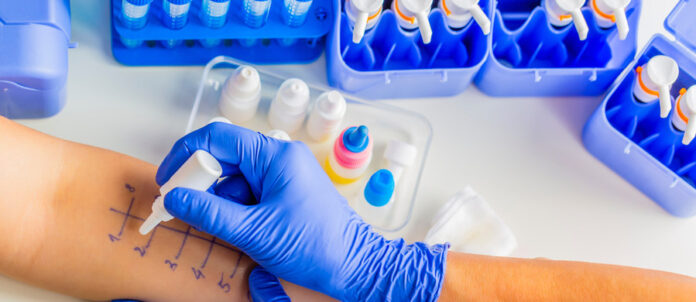SkinLogic, a Polish AI System for Allergy Detection, is designed for precise, automatic analysis of skin allergy tests. It has successfully passed clinical trials, which means that it can support doctors in making diagnoses. You can read the publication concerning the work on its development in the Scientific Reports journal.
Work on the innovative diagnostic solution was carried out by:
- a multidisciplinary team of scientists composed of engineers led by prof. Robert Nowak from the Institute of Computer Science of the Warsaw University of Technology,
- specialists in multispectral medical imaging, and doctors led by prof. Jacek Stępień from Milton Essex
- and prof. Karina Jahnz-Różyk from the Military Medical Institute.
The project was part of a more extensive research program on AI for automated medical imaging processing – IRFAN-Allergoscope.
Many people who are allergic or suspect they have an allergy know this scheme well. A visit to a specialist, puncture the fragments of the forearm to which allergen drops have been applied with a special knife, wait 20 minutes for the result, and finally – measure the bubbles with a ruler. SkinLogic can help streamline this regimen by automating the reading of skin allergy tests. It will allow you to perform them more efficiently and obtain more reliable results.
The system is based on the techniques of multispectral medical imaging using the LWIR (Long Wave Infrared) spectrum. The HYBRID II head used in the device has a unique sensor system. In combination with the AI system, it accurately estimates the severity of allergies. In the same time it reduces the risk of misdiagnosis that can occur during diagnosis using standard methods conducted by a human.
Diagnosis first
From an IT point of view, SkinLogic is a data processing system. Its base is a device consisting of a tripod and two cameras: vision and thermal.
The patient must fix his hand on a tripod. The machine takes pictures in visible and infrared light at set times. Then it records what is happening on the skin fragments treated with allergens. After receiving the documentation in digital form, it is time to use the algorithm created by scientists from the Warsaw University of Technology.
In the standard procedure, the measurement of an allergic reaction is manual and not entirely precise. In the case of SkinLogic, the algorithm performs the measurement using the images from the cameras. The system examines the size of the reaction and other parameters such as shape and unusual behavior. The LWIR view is beneficial at this stage.
Pixel accuracy
The analysis of digital material consists in dividing the photos into segments corresponding to the location of punctures on the skin. Each of these segments can be explored separately. Over time, the data analysis shows how the studied fragment has changed. The model on which SkinLogic is based, was created using 1,500 images of skin allergic reactions collected in the course of clinical trials carried out on 100 patients. These records developed by doctors were the input data for the AI system. From these, the algorithm could learn how to recognize which view represented an allergic reaction and which did not. The camera allows you to create images with a resolution of 100×100 pixels.
Previously, a doctor who examined an allergic bubble had only a surface area visible to the naked eye. Thanks to SkinLogic, it is possible to explore all pixels from the obtained images. Previously the formal diagnosis was based on just one value. Now the test result by AI is based on a million combinations detected. It would be highly tedious for a human to find these patterns. A trained algorithm handles this task quickly and is very accurate. More data means more noise to eliminate. The algorithm also deals with this problem thanks to training developed by a medical council. It is confirmed by clinical tests of the system. It correctly recognizes as many as 98% of cases, including rare allergies and those with a diameter of less than 0.3 mm.
Overcome the allergy
The system that automates the readings of skin allergy tests undergoes pre-registration tests. Making it widely available can prove to be of great help. Especially at a time when allergic diseases, including asthma, affect more and more of the population. Faster diagnoses, precise results, and the possibility of more comprehensive consultations thanks to digital documentation improve diagnosis. And decision-making regarding the use of appropriate treatment to inhibit the development of the disease.
Read also about other examples of the use of AI/ML in medicine by Polish companies:
- about MI², developer of the virus infection risk calculator, here,
- about BIOTTS, Goodsleeper, and MedApp, Polish companies from the e-health sector qualified for Google for Startups 2021, here,
- about StethoMe, the Polish inventor of the e-stethoscope, which has been recognized as one of the 20 best technology startups in the world, here.



